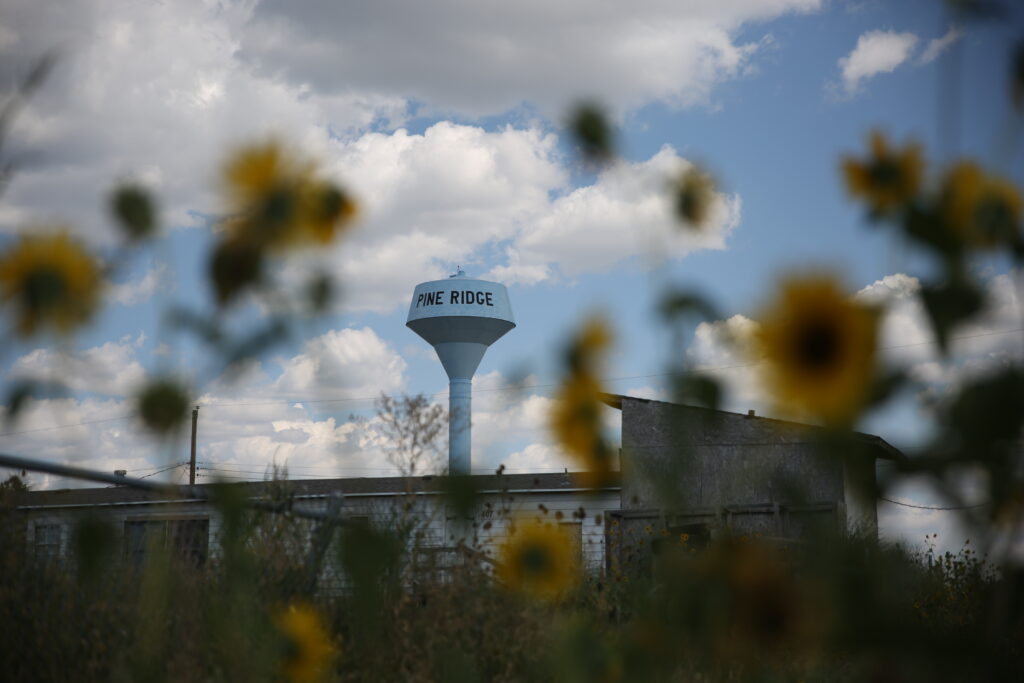Pine Ridge is located in southwestern South Dakota on the Pine Ridge Indian Reservation. The town has a population just under 3,000 and is the headquarters of the Oglala Sioux Tribe. (Photo by Makenzie Huber/South Dakota Searchlight)
For the third time since 2022, the Oglala Sioux Tribe has sued the federal government over inadequate funding for its reservation’s public safety operations.
The case filed last week in U.S. District Court for the District of South Dakota alleges that the U.S. Bureau of Indian Affairs has yet to address the shortage of officers the tribe initially sued over in 2022. It also says the BIA’s justice division once again denied requests to fund school resource officers, a canine unit, an internal affairs division and a Missing and Murdered Indigenous People investigation unit in federal fiscal year 2025, which began at the start of last October.
The other two cases, filed in 2022 and 2024, were consolidated as one in July. Those issues remain unresolved, and nothing has been filed by the tribe or the federal government since they were combined.
Treaty obligations for the federal government form the foundation for all three of the lawsuits. The first treaty that committed the U.S. government to provide for the safety of Oglala Sioux Tribal members was signed in 1825, and the commitment was reaffirmed in treaties signed in 1851 and 1868.
Law enforcement issues unresolved following Oglala Lakota lawsuit
“It is the foundation of the trust obligation owed by Defendants to the Tribe to provide adequate and effective law enforcement services,” the new lawsuit says.
According to the U.S. Census, around 20,000 people live in the borders of the tribe’s Pine Ridge Reservation, which has a land area approximately the size of Connecticut. The tribe has around 50,000 enrolled members nationwide.
Some tribes in South Dakota, like Crow Creek, rely exclusively on BIA police for law enforcement. Oglala is one of the six tribes in South Dakota that maintains its own police force using BIA funding.
In the 1990s, the force had around 150 officers. Today, there are around 30 tribal police. The tribe argues that the loss in officers dates back to 1999. The BIA altered its funding calculations that year, setting a base funding level that hasn’t changed since, the lawsuit says. The agency factored in funding provided through police-specific federal grants when it set that level, but those grants ceased to pay Oglala Sioux Tribal Police officer salaries in 2006.
The tribe’s lawsuit says the BIA has never moved to replace the grant funding.
The result, the tribe says, has been long wait times for citizens who call 911 — sometimes longer than 30 minutes — and an unworkable case load for police, who often respond without backup.
“Many E-911 calls for police service are abandoned, are not being responded to in the time required to ensure public safety or are not being properly investigated or prosecuted because there simply are not enough police officers,” the lawsuit says.
There were 165,000 calls for service in 2023. Those calls included 1,133 assaults, 1,245 domestic violence calls, 589 calls related to guns and 653 missing person reports. The figures are updates to similar statistics that appeared in the cases filed in 2022 and 2024.
The case also again points to specific areas of policing the tribe has asked for but never received.
The tribe requested $31.1 million for public safety in fiscal year 2025, including amounts for missing people, school policing, a canine unit and an office of internal affairs to manage misconduct allegations against officers.
In response, the new case says, the BIA sent the tribe a letter saying it could offer $4.2 million, which was the same amount offered in fiscal year 2024.
Similar requests were made in previous years, and are noted in the earlier lawsuits.
The new case again asks a judge to order the Department of Interior to fund the additional units the tribe proposed for 2025 and increase base funding enough to staff the Oglala Sioux Tribal Police Department at a ratio of 2.8 officers per 1,000 residents. It also demands an accounting of the BIA’s past funding decisions, and for an injunction to immediately stop the agency from continuing to use a 1999 base funding level as a starting point for policing budget requests, and a declaration that the federal government has failed to meet its treaty obligations.
Emails to Oglala Sioux Tribal President Frank Star Comes Out, the tribe’s lawyers, and a spokesperson from the BIA were not immediately returned Wednesday.


